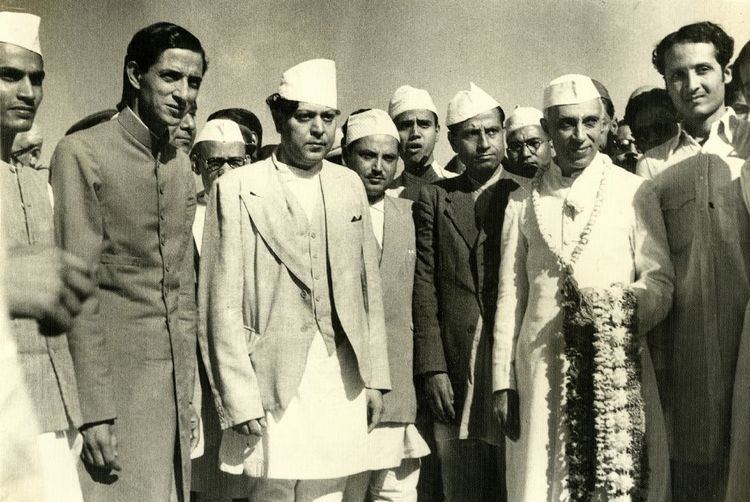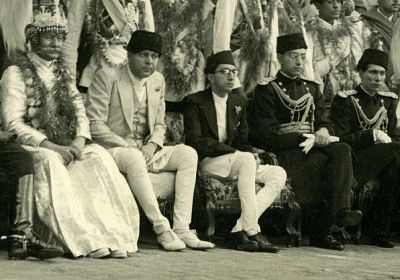Coronation 20 February 1913 Role King Name Tribhuvan Nepal | Predecessor Gyanendra Predecessor Prithvi Bikram | |
 | ||
Reign 11 December 1911 – 7 November 1950 Successor Gyanendra (his Grandson) Reign 18 February 1951 – 13 March 1955 | ||
Tribhuwan Bir Bikram Shah.(त्रिभुवन वीर विक्रम शाह), (June 23, 1903 – March 13, 1955) was King of Nepal from 11 December 1911 until his death (not considering his exile from 7 November 1950 to 18 February 1951). Born in Kathmandu, the capital city of Nepal, he ascended to the throne at the age of five, upon the death of his father, King Prithvi Bir Bikram Shah, and crowned on 20 February 1913 at the Nasal Chowk, Hanuman Dhoka Palace in Kathmandu, with his mother acting as regent. At the time, however, the position of monarch was mainly titular, with real power in the country residing in the powerful, conservative Rana family, which supplied the country with its hereditary prime minister. The Rana period is known for the tyranny, debauchery, economic exploitation and religious persecution by the rulers.
Contents
- state funeral of king tribhuvan of nepal 1955 ad
- Family
- Later life
- Congress Rana Government
- Death
- Honours
- References

state funeral of king tribhuvan of nepal 1955 ad
Family

King Tribhuvan was born on June 23, 1903 to Prithvi Bir Bikram Shah and Queen Divyeshwari Laxmi Devi Shah. After the death of his father, Tribhuvan Bir Birkarm Shah ascended the throne on December 11, 1911, at the age of eight. Queen Mother Divyeshwari Laxmi Devi was appointed the regent until King Tribhuvan would come to his age. In a double ceremony, he married first at the Narayanhity Royal Palace, Kathmandu, March 1919, H.M. Svasti Sri Ojaswi Rajanya Sri Sri Sri Sri Sri Sriman Maharajadhiraja Patta Rajninam Bada Maharani Kanti Rajya Laxmi Devi Shahanam Sada Saubhajnabatinam (H.M. Queen Kanti). The same day he also married her sister, H.M. Svasti Sri Ojawsi-Rajanya Sri Sri Sri Sri Sri Sriman Maharajadhiraja Patta Rajninam Kancha Maharani Ishwari Rajya Laxmi Devi Shahanam Sada Saubhajnabatinam (H.M. Queen Ishwari). Both were full sisters (in an arranged custom in their young age). He also had junior wives.
King Tribhuvan had three sons and thirteen daughters. They include:
The daughters include:
Children of junior wives include:
Three unnamed daughters of King Tribhuvan perished during the Great earthquake, at the Narayanhity Royal Palace, Kathmandu, 15 January 1934.
Later life
Tensions between the royal family and the Ranas came to a head during World War I. The Ranas wanted to join the war in support of Britain, which controlled India to the south. The prime minister, HH Maharaja Sri Chandra Shamsher Jang Bahadur Rana always had his way with the young king, who eventually ordered the troops to go to war.
By the mid-1930s, popular discontent with the Ranas led to the establishment of several movements, notably the Nepal Praja Parishad, to which Tribhuvan himself gave explicit support, to overthrow the Ranas. In each instance, however, the Ranas responded harshly, banning the liberal movements and executing their leadership.
King Tribhuvan worked closely with Praja Parishad to abolish the Rana regime. In November, 1950, King Tribhuvan took refuge at the Indian Embassy in a campaign aimed at removing the Rana oligarchy from power, which had ruled Nepal for more than a century. He was accompanied by his son Mahendra and the eldest grandson Birendra, among others. Prime Minister Sir Tin Maharaja, Mohan Shamsher Jang Bahadur Rana became furious and responded to Tribhuvan's move by calling an emergency meeting of the cabinet on 7 November 1950 at Singha Durbar. In that meeting he announced Gyanendra Bir Bikram Shah, the four-year-old grandson of King Tribhuvan as the new King of Nepal. In the afternoon, on the same day, Prince Gyandendra Bir Bikram Shah was brought to Hanuman Dhoka Palace and crowned as the king of Nepal. On 10 November, two Indian planes landed at Gauchar Airport and flew back to New Delhi with the Royal family excluding the infant King, Gyanendra. King Tribhuvan was formally welcomed by the Indian prime minister Jawahar Lal Nehru and other high officials. The removal of the king led to huge demonstrations in the country that compelled the Rana prime minister, Mohan Shamsher Jang Bahadur Rana to come into negotiations with Tribhuvan and the Nepali Congress. On November 22, 1950, Jawahar Lal Nehru, the Prime Minister of India, officially announced that India was not going to recognize Gyanendra Bir Bikram Shah as the legitimate King of Nepal. When Mohan Shumsher saw that the situation was out of his control, he sent the king's brother-in-law, Sir Kaiser Shamsher Jang Bahadur Rana and Bijaya Shamsher Jang Bahadur Rana to New Delhi for peace talks. In New Delhi, King Tribhuvan, representatives of Nepali Congress and of the Rana Government all sat together to discuss the situation. At last an agreement was reached according to which King Tribhuvan to form a new ministry, under his leadership, consisting of the Nepali Congress and the Ranas on an equal basis, King Tribhuvan flew back to Nepal, along with the members of the Royal family and the leaders of the Congress Party on 15 February 1951. On February 18, 1951, King Tribhuvan returned from India as the monarch. Three days after the return, Tribhuvan formally declared an end to Rana's family rule and established a democratic system, but Mohan Shamsher continued as a prime minister for a few more months.
Congress Rana Government
According to the New Delhi Agreement, King Tribhuvan announced on 13 February 1951, a cabinet headed by Sir Mohan Shamsher Jang Bahadur Rana. The followings were the members of the Cabinet.
From the Rana clan:
From the Nepali Congress side:
This cabinet was reshuffled on 10 June 1951 to replace Baber Shamsher by Shangha Shamsher and Bharatmani Sharma by Surya Prasad Upadhyaya. This cabinet was dissolved in November 1951 and MP Koirala became the new Prime Minister.
Death
King Tribhuvan died in 1955 in Zürich, Switzerland, under mysterious circumstances. He was aged 52. He was succeeded by his eldest legitimate son Mahendra.
The international airport in Kathmandu, Tribhuvan International Airport, the oldest highway in Nepal Tribhuvan Highway, the 2nd oldest association football tournament in Nepal, Tribhuvan Challenge Shield, a city, Tribhuvannagar in Dang valley, and the country's largest university (Tribhuvan University) are named after him.
